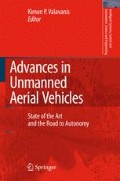Abstract
The answer to the simple question “Why UAVs?” is more than obvious when one focuses on military applications. The focus on and the perspective from the military point of view (overlooking civilian applications) is justified by the fact that even today UAVs are basically and mostly used in the battlefield. Therefore, the answer to the posed question is given in terms of the UAV definition and types of military missions they are suitable for.
Access this chapter
Tax calculation will be finalised at checkout
Purchases are for personal use only
Preview
Unable to display preview. Download preview PDF.
References
Unmanned Vehicles Handbook 2002, The Shepard Press, 2002.
Unmanned Aircraft Systems Roadmap 2005–2030, Office of the Secretary of Defense, August 2005.
OSD UAV Roadmap 2002–2027, Office of the Secretary of Defense Acquisition, Technology, & Logistics, Air Warfare, December 2002.
Vachtsevanos G., Tang L., and Reimann J. “An Intelligent Approach to Coordinated Control of Multiple Unmanned Aerial Vehicles,” Proceedings of the American Helicopter Society 60 th Annual Forum, Baltimore, MD, June 2004.
Vachtsevanos G., Kim W., AI-Hasan S., Rufus F., Simon M, Schrage D., and Prasad J. V. R., “Mission Planning and Flight Control: Meeting the Challenge with Intelligent Techniques”, Journal of Advanced Computational Intelligence, Vol. 1,(1), pp. 62–70, October 1997.
Vachtsevanos G., Ludington B., Reimann J., Antsaklis P., Valavanis K., “Modeling and Control of Unmanned Aerial Vehicles — Current Status and Future Directions”, CD-ROM Proceedings, 13 th Mediterranean Conference on Control and Automation, Cyprus, June 2005.
Author information
Authors and Affiliations
Editor information
Editors and Affiliations
Rights and permissions
Copyright information
© 2007 Springer. Printed in the Netherlands
About this chapter
Cite this chapter
Valavanis, K.P., Vachtsevanos, G.J., Antsaklis, P.J. (2007). Conclusions and the Road Ahead. In: Valavanis, K.P. (eds) Advances in Unmanned Aerial Vehicles. Intelligent Systems, Control and Automation: Science and Engineering, vol 33. Springer, Dordrecht. https://doi.org/10.1007/978-1-4020-6114-1_18
Download citation
DOI: https://doi.org/10.1007/978-1-4020-6114-1_18
Publisher Name: Springer, Dordrecht
Print ISBN: 978-1-4020-6113-4
Online ISBN: 978-1-4020-6114-1
eBook Packages: EngineeringEngineering (R0)

